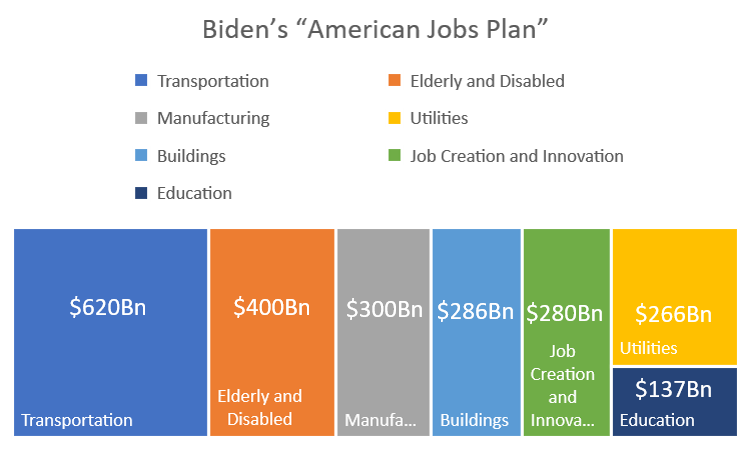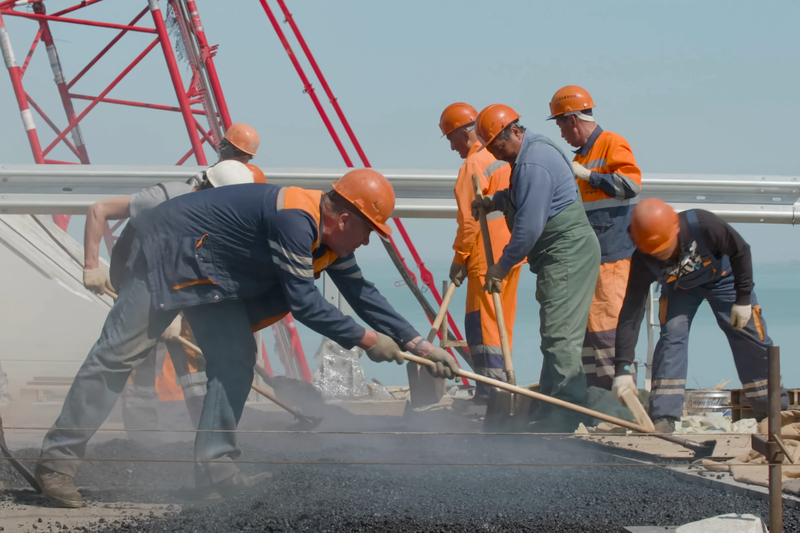America is one of the globe’s richest countries; yet, its infrastructure is aging and crumbling. For a score of years, the American Society of Civil Engineers (ASCE) has awarded a grade of “D” to America’s infrastructure as roads deteriorated, bridges rusted, and waterways clogged. According to ASCE, “The 10-year infrastructure investment gap now stands at $2.6 trillion, up from $2.1 trillion in 2017.”[1] According to ASCE, things have improved slightly. Cristina Commendatore (@CristinaC_FO), Executive Editor of FleetOwner magazine, reports, “For the first time in 20 years, America’s grade point average for infrastructure is finally out of the D range. This year, the American Society of Civil Engineers gave the nation a grade of C- for its cumulative GPA. Although this year’s grade is an improvement from the dismal D+ that the ASCE gave the nation’s infrastructure in 2017, 11 of the 17 categories in this year’s report card received a grade in the ‘D’ range — and that includes roads.”[2] In a statement released to the press, ASCE Executive Director Tom Smith stated, “This is not a report card anyone would be proud to take home. We have not made significant enough investments to maintain infrastructure that in some cases was built more than 50 years ago.”[3]
Despite verbal bipartisan support for infrastructure improvements, Democrat and Republican administrations have failed to pass meaningful legislation for decades. Speaking at a virtual ASCE conference, U.S. Secretary of Transportation Pete Buttigieg insisted “now is the time to act on a generational opportunity to fix America’s crumbling infrastructure.”[4] He added, “The American people already want us to do this. And I think infrastructure is already one of the most bipartisan things that this administration is taking on.” Unfortunately, partisan politics is again raising its ugly head.
Is the Biden Administration Trying to Do Too Much?
When President Joe Biden introduced his “infrastructure” bill to the nation, many people were surprised the bill was not laser-focused on infrastructure. Journalists Andrew Restuccia (@AndrewRestuccia) and Tarini Parti (@tparti) report, “Mr. Biden’s proposal includes $621 billion to modernize transportation infrastructure, $400 billion to help care for the aging and those with disabilities, $300 billion to boost the manufacturing industry, $213 billion on retrofitting and building affordable housing and $100 billion to expand broadband access, among other investments.”[5] Biden calls it an American Jobs Plan.

Restuccia and Parti report, “The plan, which requires congressional approval, calls for modernizing 20,000 miles of roadway; building 500,000 electric-vehicle charging stations; replacing the country’s existing lead pipes and service lines; repairing aging schools; expanding home care for the elderly and disabled; and investing billions of dollars in domestic semiconductor manufacturing. Mr. Biden also proposes mandating that more of the country’s electricity be generated from low-carbon sources, with a goal of eliminating carbon emissions from the power grid by 2035. Mr. Biden’s plan stresses equity in access to jobs and transportation options, including $20 billion for a new program that would reconnect neighborhoods cut off by past transportation investments as well as research funding for historically Black colleges and universities. The plan calls for a national climate-focused laboratory to be affiliated with an HBCU.” The Wall Street Journal provides an excellent graphic breakdown of the plan, which can be seen by following this link (subscription required).
Despite containing many things both sides of the aisle support, objections were heard from both the right and the left after the plan was introduced. Reporter Heather Long (@byHeatherLong) explains, “While there’s widespread support across the political aisle to upgrade the nation’s infrastructure, critics of Biden’s plan ― and even some of its supporters ― have raised questions whether all the spending in the plan is truly needed, whether the tax increases on corporations are excessive and why the White House is using an unusual accounting approach to capture the deficit impact.”[6]
Supporters of the Plan
One of the most prominent experts supporting the Biden plan is Columbia University Professor Joseph Stiglitz (@JosephEStiglitz), a Nobel Prize laureate in economics. In an interview with Dion Rabouin (@DionRabouin), Editor of the Axios Markets newsletter, Stiglitz stated, “We’ve been for the last two decades in an abnormal environment, we’ve been in a bad equilibrium trap. The inequality means people don’t have demand, a lack of demand means we don’t invest, so we’ve been in a very bad, vicious circle and I’m optimistic that this may break us out into a new period of strong growth, which is more egalitarian.”[7] Stiglitz believes, if the Biden plan is enacted, “We’re going to heat up the economy. We’re going to be investing, spending money on education, child care, a whole variety of expenditures across the spectrum and not just giving money to the very rich but giving money to people who actually spend it. That will create more demand and that should give people more confidence to invest.”
Political columnist Fareed Zakaria (@FareedZakaria) observes, “Washington in recent years has mostly spent money to fund private consumption by giving people tax cuts or transfer payments. Biden’s infrastructure plan is the first major fiscal program in five decades that would focus once again on investment.”[8] Zakaria’s support for the plan, however, is tempered by the country’s lack of innovation when it comes to constructing infrastructure. He explains, “Americans [are] unwilling or unable to look around the world and try to learn from other countries. American exceptionalism has led to an exceptional, uniquely bad system for building infrastructure.”
Those Opposing the Plan
Those opposing Biden’s plan offer two main objections. First, its scope is too broad. R. Richard Geddes, an infrastructure economist who advised President George W. Bush, explained, “They have a giant definition of infrastructure. These social issues are very important, but they aren’t nuts and bolts. We need to focus like a laser beam.”[9] The second, and far more emotional, objection to the plan is raising taxes to pay for it. Despite facing the largest federal deficit since the Second World War, Republicans are loathe to address deficit spending by raising taxes ― especially when they view that spending as advancing a liberal agenda. Axios reports, “A new memo from House Minority Leader Kevin McCarthy says: ‘Biden’s so-called infrastructure plan spends less than 6 percent to repair bridges, highways, and roads. The rest is a “kitchen sink” of wasteful progressive demands.'”[10]
The Wall Street Journal editorial board sums up the attack opponents will make. It writes, “Most Americans think of infrastructure as roads, highways, bridges and other traditional public works. That’s why it polls well, and every President has supported more of it. Yet this accounts for a mere $115 billion of Mr. Biden’s proposal. There’s another $25 billion for airports and $17 billion for ports and waterways that also fill a public purpose. The rest of the $620 billion earmarked for ‘transportation’ are subsidies for green energy and payouts to unions for the jobs his climate regulation will kill. This is really a plan to build government back bigger than it has ever been.”[11]
Concluding Thoughts
Political writer Greg Sargent (@ThePlumLineGS) asserts Biden’s plan will reveal geographical, as well as ideological, differences between Democrats and Republicans. He writes, “With Republicans increasingly becoming concentrated in rural, small-town and exurban America, even as Democrats are increasingly concentrated in cosmopolitan areas and inner suburbs, their priorities on infrastructure have cleaved.”[12] What politicians on both sides of the aisle need to remember is that America’s infrastructure needs help. Let’s hope they can set aside partisan politics long enough to compromise on a bill that helps all Americas, regardless of where they live. President Biden asserts, “It is not a plan that tinkers around the edges. It is a once-in-a-generation investment in America.” It may also be a bridge too far. Jacob Arlein, a principal at the engineering and energy efficiency consultancy Stok, summed up what many people are feeling. “The amount of money in this bill is staggering, and the commitment to spend some of the money to directly address climate change is a huge step forward,” he said. “There are many winners that will benefit from this bill, and that may be its downfall. It tries to tackle myriad problems beyond infrastructure, and putting too many of these problems in one behemoth omnibus bill will make it difficult to pass.”[13]
Footnotes
[1] Chris Teale, “US infrastructure funding gap swells to $2.6 trillion: ASCE,” Smart Cities Dive, 4 March 2021.
[2] Cristina Commendatore, “America’s infrastructure gets a C-, marking 20-year first,” FleetOwner, 4 March 2021.
[3] Teale, op. cit.
[4] Joe Bousquin, “Buttigieg says infrastructure faces a ‘once-in-a-lifetime moment’ as bridges, roads get C- grade,” Construction Dive, 4 March 2021.
[5] Andrew Restuccia and Tarini Parti, “Biden’s $2.3 Trillion Infrastructure Plan Takes Broad Aim,” The Wall Street Journal, 31 March 2021.
[6] Heather Long, “Biden’s infrastructure plan faces controversy over price tag and design,” The Washington Post, 31 March 2021.
[7] Dion Rabouin, “Biden’s spending plans could remake the economy, says Nobel Prize winner Stiglitz,” Axios, 30 March 2021.
[8] Fareed Zakaria, “How Biden’s New Deal can really make America great again,” The Washington Post, 1 April 2021.
[9] Long, op. cit.
[10] Lachlan Markay and Alayna Treene, “Inside Republicans’ battle plan on infrastructure,” Axios, 2 April 2021.
[11] Editorial Board, “Biden Defines Infrastructure Down,” The Wall Street Journal, 1 April 2021.
[12] Greg Sargent, “How the coming war over infrastructure will reveal even deeper divisions,” The Washington Post, 1 April 2021.
[13] Joe Bousquin, “Biden’s $2 trillion infrastructure plan has something for everyone. And that’s its biggest risk.” Construction Dive, 1 April 2021.





